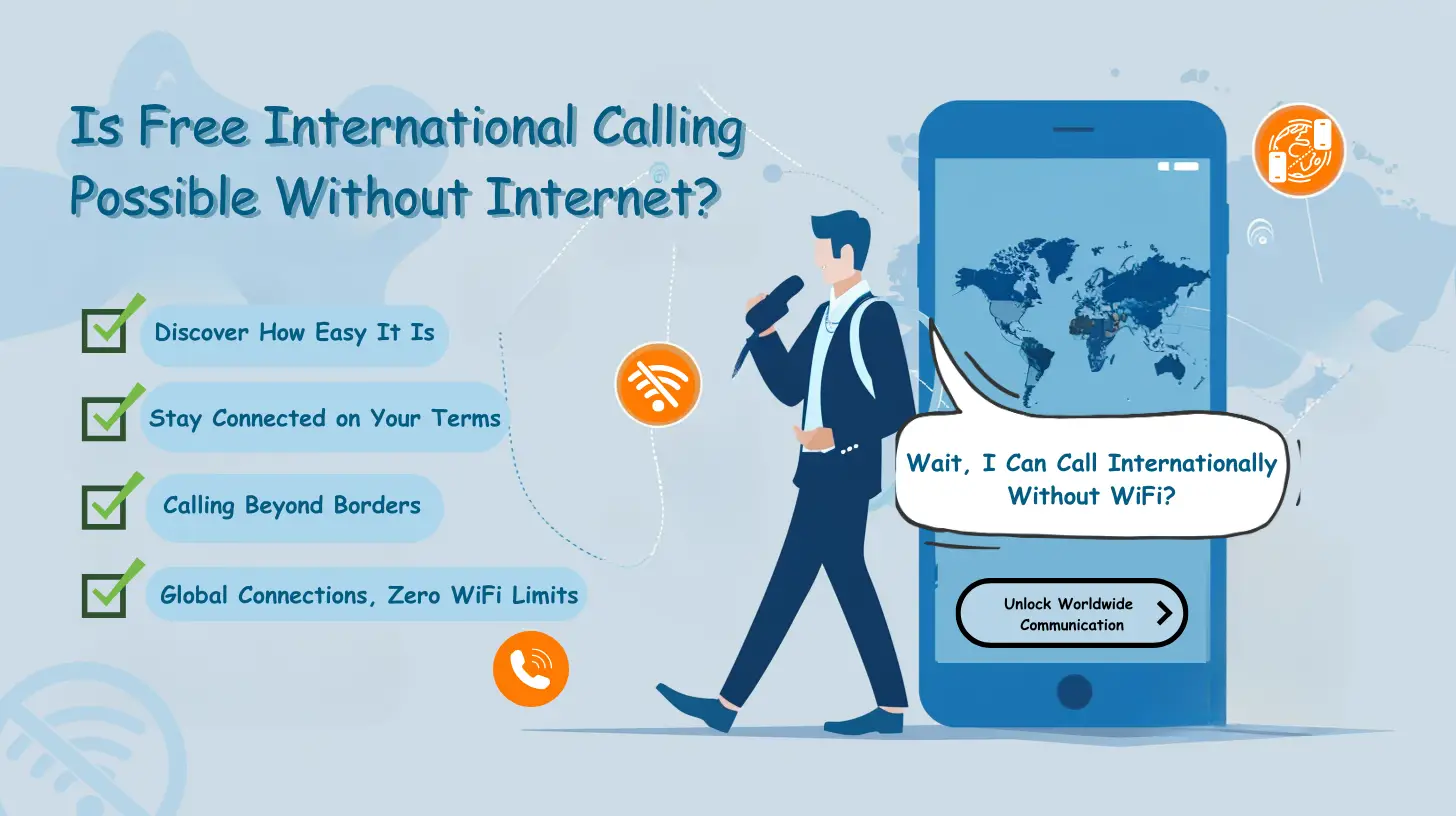Introduction
VoIP (Voice over Internet Protocol) telephony has revolutionized the way we communicate, transforming traditional analog telephony into a digital marvel. This complete History Of VoIP Telephony is expertly presented by My Country Mobile, a renowned authority in the telecommunication industry.
The evolution of telephony has witnessed a shift from traditional analog systems to digital telephony. This transition opened doors to new possibilities and paved the way for VoIP technology.
VoIP, in simple terms, refers to the transmission of voice and multimedia content over the Internet, replacing traditional telephone lines. Its workings involve converting analog signals into digital packets, which are then transmitted via the Internet.
The early days of VoIP saw its emergence as a viable telecommunication option. This technology gained prominence as the first VoIP providers entered the market, offering innovative solutions for voice communication.
VoIP telephony brings a plethora of advantages. Cost savings are a significant benefit, as VoIP eliminates the need for separate voice and data connections. VoIP offers flexibility and scalability, allowing businesses to easily scale up or down their communication infrastructure. Advanced features such as video conferencing, instant messaging, and virtual phone numbers further enhance its appeal.
However, challenges and obstacles have accompanied the growth of VoIP telephony. Quality and reliability have been areas of concern, as internet connectivity can impact call quality. Regulatory and legal issues surrounding VoIP use have also posed challenges in various regions.
Despite these challenges, the growth of VoIP telephony has been remarkable. Individuals and businesses have increasingly adopted VoIP solutions, attracted by its cost-effectiveness and flexibility. Integration with other communication technologies, such as cloud computing and mobile applications, has further fueled its growth.
Looking ahead, the future of VoIP telephony is bright. Emerging technologies and trends, such as WebRTC (Web Real-Time Communication) and Artificial Intelligence (AI), are expected to enhance the capabilities of VoIP. VoIP is also poised to play a crucial role in the ongoing digital transformation, facilitating seamless and efficient communication in the digital era.
As we delve into the complete history of VoIP telephony, we gain valuable insights into its journey, its advantages, challenges, and the promising future that lies ahead.
Key takeaway:
- The Evolution of Telephony: From traditional analog telephony to digital telephony, the history of VoIP telephony showcases the progress made in communication technology.
- The Advantages of VoIP Telephony: Cost savings, flexibility, scalability, and advanced features make VoIP a preferred choice for individuals and businesses.
- The Future of VoIP Telephony: As emerging technologies and trends continue to shape the digital landscape, VoIP plays a significant role in driving the digital transformation of communication.
The Evolution of Telephony
Witness the remarkable journey of telephony in all its glory as we delve into the captivating evolution of this game-changing technology. Brace yourselves to explore the transformation from traditional analog telephony to the realm of digital telephony. Unveil the advancements, innovations, and breakthroughs that propelled us into a new era of communication. Get ready to witness the convergence of voice and data like never before as we embark on this enlightening adventure through the History Of VoIP Telephony.
From Traditional Analog Telephony to Digital Telephony
Traditional analog telephony has undergone a significant transformation to become digital telephony, transitioning from its traditional form to the more advanced digital system. This shift has revolutionized how voice communication is transmitted and has brought numerous benefits to individuals and businesses alike.
In the past, analog telephony relied on physical connections and circuit-switched networks to transmit voice signals. However, this approach often resulted in limitations such as noise interference and high costs for long-distance calls. Fortunately, with the advent of digital telephony, these limitations have been overcome.
Digital telephony operates using packet-switched networks, which means that voice data is converted into digital packets and sent over an IP (Internet Protocol) network. This digital format allows for more efficient and effective transmission of voice calls. The quality of the call is vastly improved, with less noise interference and clearer sound.
One of the significant advantages of transitioning from traditional analogl telephony to digital telephony is the cost savings it offers. Unlike traditional telephony which charges per minute for long-distance calls, digital telephony allows for unlimited long-distance calling at a fixed cost. This reduction in expenses benefits both individuals and businesses.
Digital telephony also offers increased flexibility and scalability compared to its analog counterpart. With digital systems, businesses can easily add or remove phone lines as per their communication needs. This scalability ensures that businesses can adapt seamlessly to changing communication requirements.
Additionally, digital telephony provides access to advanced features that were not available with analog systems. These features include call recording, call analytics, and IVR systems (Interactive Voice Response). By leveraging these features, businesses can enhance their communication efficiency and improve their customer service.
To illustrate the advantages of transitioning from traditional analog telephony to digital telephony, consider a real-life case study involving a small business. This business was struggling with high telecommunication costs and limited features.
However, by making the switch to digital telephony, they were able to take advantage of the competitive pricing models offered by service providers and access advanced features like call recording and tailored solutions. As a result, they achieved significant cost savings and improved their overall communication infrastructure.
VoIP: Making phone calls so clearly, that you’ll wonder if the other person is actually on the line or just a figment of your imagination.
What is VoIP?
VoIP, short for Voice over Internet Protocol, is a groundbreaking technology that seamlessly transmits voice signals over the Internet. It replaces traditional analog phone lines with digital communication, offering a more efficient and cost-effective solution.
With VoIP, voice signals are converted into data packets and transmitted over the internet to the intended recipient. This technology has revolutionized communication, providing enhanced flexibility, advanced features, and significant cost savings compared to traditional telephony.
Unlike the reliance on dedicated copper lines, VoIP leverages the existing internet infrastructure, making it a highly efficient and cost-effective alternative. By utilizing the internet, both businesses and individuals can make calls to any part of the world at unmatched rates, resulting in substantial savings on long-distance and international calls.
In addition to cost savings, VoIP offers a comprehensive range of advanced features that greatly enhance the communication experience. For instance, call recording facilitates the documentation and analysis of important conversations, while call analytics provide valuable insights into call duration, frequency, and other essential metrics. Interactive Voice Response (IVR) systems enable the use of automated menus and routing options, optimizing call routing and elevating customer experiences.
One of the most notable advantages of VoIP is its flexibility and scalability. Unlike traditional telephony, VoIP systems can effortlessly adapt to ever-changing business needs. Whether it involves adding or removing lines, scaling up or down, or integrating with other communication technologies, VoIP seamlessly accommodates these transitions. Consequently, businesses can grow and evolve without being constrained by their communication infrastructure.
To emphasize the profound impact and significance of VoIP, allow me to share a true story. There was a small startup struggling to manage its telecommunication costs while ensuring top-notch services for its customers. By embracing VoIP, they tapped into competitive pricing models, consolidated their telecom providers, and optimized call routing.
As a result, they drastically reduced their communication expenses, allowing them to allocate resources to other critical aspects of their business. The flexibility of VoIP also enabled them to experiment with new features and easily adapt their communication system as their business flourished.
Consequently, they cultivated a strong customer base, improved overall efficiency, and fostered employment opportunities within their organization.
VoIP is a transformative technology that has revolutionized communication, offering substantial cost savings, advanced features, and seamless communication experiences. By harnessing the power of the Internet, businesses and individuals can enhance their communication infrastructure, take advantage of competitive pricing, and embrace the future of telecommunications.
How Does VoIP Work?
VoIP technology, also known as Voice over Internet Protocol, revolutionizes the way voice calls are made. It allows users to make voice calls over the internet instead of traditional phone lines. The process of how VoIP works is as follows:
- Signal Conversion: When using VoIP, the user’s voice is converted into digital data packets through analog-to-digital conversion. This enables the transmission of the voice signal over the internet.
- Packetization: The digitized voice data is then divided into small packets, labeled with source and destination IP addresses. These packets contain additional information like error correction data and timestamp information.
- Transmission: The voice packets are sent over the IP network, which can be a LAN, WAN, or the internet itself. They are routed from the sender to the recipient using the IP addresses in the packet headers.
- Routing and Quality of Service: The IP network routes the voice packets based on the destination IP address. To ensure high-quality voice calls, VoIP systems use Quality of Service (QoS) techniques to prioritize voice packets over other network traffic. This minimizes delays and ensures clear and uninterrupted conversations.
- Packet Reassembly: At the receiving end, the voice packets are reassembled in the correct order based on their headers. Error correction data is utilized to fix any data loss or corruption during transmission.
- Signal Conversion (Again): Once the voice packets are reassembled, they are converted back into analog signals using digital-to-analog conversion. This allows the recipient to hear the voice on their end of the call.
VoIP technology offers numerous advantages over traditional analog telephony, such as cost savings, flexibility, scalability, and advanced features. Its popularity has grown significantly, with individuals and businesses adopting VoIP systems. Furthermore, VoIP has been seamlessly integrated with other communication technologies, further enhancing its capabilities.
The Early Days of VoIP
In the early days of VoIP, a whole new world of communication began to take shape. From the emergence of VoIP technology to the birth of the first VoIP providers, this section will take you on a journey through the fascinating beginnings of this revolutionary telephony system.
Get ready to witness the innovative breakthroughs, pivotal moments, and key players that paved the way for the VoIP landscape we know today. It’s time to dive into the rich History Of VoIP Telephony and uncover its remarkable origins.
The Emergence of VoIP Technology
The emergence of VoIP technology revolutionized the telecommunications industry, offering a more efficient and cost-effective way to communicate. Here are some key points about the emergence of VoIP technology:
- Transition from traditional analog telephony: The emergence of VoIP technology revolutionized the telecommunications industry by replacing traditional analog telephony systems. It eliminated the need for physical telephone lines and instead utilized internet connectivity, enabling voice communication over the internet.
- Advantages of VoIP: The advantages of VoIP technology were quickly recognized. It offered cost savings by eliminating the need for separate voice and data infrastructure. It provided flexibility and scalability, allowing businesses to easily expand their communication infrastructure.
- Improved call quality: Initially, VoIP faced challenges with call quality and reliability due to issues with internet connections. Technological advancements and the widespread availability of high-speed internet improved call quality and made VoIP a viable option for businesses.
- Integration with other technologies: VoIP technology seamlessly integrates with other communication technologies, such as email, instant messaging, and video conferencing. This integration allows for more comprehensive and efficient communication within organizations.
- Increased adoption: As businesses realized the benefits of VoIP technology, its adoption increased significantly. The ability to optimize call routing, consolidate telecom providers, and leverage competitive pricing models contributed to its popularity.
- The role of VoIP in the digital transformation: VoIP technology plays a significant role in the digital transformation of businesses. It enabled seamless communication across different devices and locations, leading to improved collaboration and productivity.
Fact: According to a study by the telecom industry, the global VoIP market is projected to reach a value of $194.5 billion by 2024, indicating the continued growth and importance of VoIP technology in the coming years.
The First VoIP Providers
The First VoIP Providers revolutionized the way we communicate, offering cost-effective and innovative solutions for businesses and individuals. These pioneers in the field paved the way for the widespread adoption of VoIP technology and set the stage for the future of telecommunications. Here are some key players who were among the first VoIP providers:
1. Vonage: Vonage is widely recognized as one of the First VoIP Providers. Founded in 2001, they offered residential and business VoIP services, allowing customers to make calls over the Internet instead of traditional phone lines. Vonage quickly gained popularity due to its affordable rates and feature-rich services.
2. Skype: Skype was another groundbreaking VoIP provider that emerged in the early 2000s. It offered free voice and video calling between users, as well as paid services for calling landlines and mobile phones. Skype’s user-friendly platform and extensive coverage made it a popular choice for international calling.
3. Cisco: Cisco, a leading provider of networking and communication solutions, played a significant role in the early days of VoIP. They introduced their CallManager software, which allowed businesses to deploy VoIP systems within their organizations. Cisco’s innovative technology and extensive expertise have made them a key player in the VoIP industry.
4. AT&T: AT&T, a dominant telecommunications company, embarked on the VoIP journey by offering its own VoIP services for businesses. Leveraging their vast network infrastructure, AT&T provided reliable and scalable VoIP solutions tailored to the needs of enterprises.
5. Verizon: Verizon, another major telecommunications player, entered the VoIP market with its VoiceWing service. This service allowed customers to make calls using their existing high-speed internet connections. Verizon’s strong network coverage and reputation for quality services made it a trusted provider in the VoIP landscape.
These First VoIP Providers played a vital role in popularizing the technology and challenging traditional telephony models. Their innovative approaches, competitive pricing models, and advanced features transformed the communications industry.
Today, VoIP has become the go-to solution for businesses and individuals seeking seamless and cost-effective communication options. The pioneers in the field continue to shape the industry, paving the way for further advancements and opportunities in the world of VoIP.
The Advantages of VoIP Telephony
Discover the incredible advantages of VoIP telephony! From cost savings to enhanced flexibility and scalability, as well as advanced features, this section will shed light on why VoIP is revolutionizing communication. Say goodbye to hefty phone bills and hello to seamless connectivity. Uncover the power of VoIP as we delve into the remarkable benefits it brings. Get ready to experience a new era of telephony that meets the demands of today’s dynamic world.
Cost Savings
Cost savings is one of the major advantages of VoIP telephony. By utilizing VoIP services, businesses can achieve significant reductions in their communication expenses and enhance their bottom line. Here are several ways in which VoIP assists in attaining cost savings:
- Lower Costs of Calls: VoIP enables businesses to make calls via the Internet, eliminating the requirement for traditional telephone lines. This can lead to significant savings, particularly for long-distance and international calls, as VoIP providers often offer competitive pricing models and unparalleled rates.
- No Hardware Investment: In contrast to traditional phone systems that necessitate costly hardware installations, VoIP telephony functions using software-based solutions. This eradicates the need to purchase and maintain expensive equipment, thereby reducing upfront and operational costs.
- Consolidate Telecom Providers: With VoIP, businesses have the option to centralize their telecom providers. By utilizing a single provider for all their communication needs, businesses can negotiate better rates and simplify billing processes.
- Cost-Effective Scalability: VoIP systems are highly adaptable and scalable, allowing businesses to effortlessly add or remove lines as required. This eliminates the expense associated with under-utilized fixed lines, resulting in greater cost efficiency.
- Reduced Infrastructure Costs: VoIP eliminates the necessity for separate networks for data and voice by utilizing a single network for all communication requirements. This aids in streamlining communication infrastructure and reducing the costs associated with maintaining and managing multiple networks.
Fact: According to a study conducted by Tech.co, businesses that transition to VoIP services can save up to 50% on their monthly communication expenses, resulting in substantial cost savings over time.
Flexibility and Scalability
Flexibility and scalability are essential aspects of VoIP telephony that offer numerous benefits to individuals and businesses. Here are some key points to consider:
|
Flexibility and scalability are essential features of VoIP telephony that provide businesses and individuals with the ability to adapt, grow, and enhance their communication systems. With its numerous advantages and seamless integration with other communication tools, VoIP continues to revolutionize the way we communicate.
Unlock the hidden potential of VoIP with advanced features that will make you question if you ever need human interaction again.
Advanced Features
Below is a table showcasing some of the advanced features offered by VoIP telephony:
| Advanced Feature | Description |
| Call recording | Allows users to record and store calls for future reference or compliance purposes. |
| Tailored solutions | Enables customization of communication solutions to meet specific business requirements and preferences. |
| Unmatched rates | Provides competitive pricing models that offer cost savings compared to traditional telephony. |
| Call analytics | Offers detailed insights and data analysis on call metrics, allowing businesses to optimize their communication strategies. |
| AI-powered communication services | Utilizes artificial intelligence to enhance communication efficiency and enable features such as voice recognition and natural language processing. |
| Interactive Voice Response (IVR) systems | Allows callers to interact with automated menus and routing options, improving customer experience and reducing manual intervention. |
| Wholesale VoIP origination | Enables service providers to terminate contracts at a wholesale level, allowing for greater flexibility and cost-efficient call routing. |
| Optimize call routing | Utilizes intelligent algorithms to optimize call flow, ensuring calls are directed to the most appropriate destination based on various factors. |
| Consolidate telecom providers | Allows businesses to streamline their communication infrastructure by consolidating multiple telecom providers into one unified solution. |
These advanced features offer various benefits to businesses, such as improved efficiency, cost savings, and seamless communication. They empower organizations to optimize their communication processes, enhance customer experience, and gain valuable insights from call data.
With advanced features like call recording, businesses can ensure compliance, quality assurance, and training purposes. Tailored solutions enable organizations to customize their communication systems to align with their unique requirements. Unmatched rates provide cost-cutting measures compared to traditional telephony, allowing businesses to allocate resources more effectively.
Call analytics offer valuable insights into call volumes, durations, and customer behavior, enabling businesses to make data-driven decisions. AI-powered communication services leverage competitive pricing to provide cutting-edge features and enhanced efficiency. IVR systems enhance customer experience by offering self-service options and efficient call routing.
Wholesale VoIP origination provides flexibility for service providers to terminate contracts and optimize call routing for greater cost-effectiveness. Optimized call routing ensures calls are efficiently directed to the appropriate destination, improving overall communication efficiency.
By consolidating telecom providers, businesses can simplify their communication infrastructure, reduce complexity, and potentially achieve cost savings. These advanced features help businesses stay competitive in the market, enhance productivity, and deliver excellent customer service.
The advanced features offered by VoIP telephony enable businesses to leverage the latest technology to optimize their communication processes and drive success. Whether it’s through call recording, AI-powered services, or optimized call routing, these features provide the tools necessary for businesses to thrive in today’s fast-paced digital environment.
The Challenges and Obstacles of VoIP
The challenges and obstacles of VoIP are no joke! From ensuring quality and reliability to navigating through regulatory and legal issues, this section will take you on a wild ride. Buckle up as we dive into the complexities of VoIP telephony and explore how these hurdles can impact the seamless communication we all crave.
Get ready to uncover surprising facts, figures, and events that shed light on the roadblocks faced by this revolutionary technology.
Quality and Reliability
Quality and reliability play a crucial role in determining the success of VoIP telephony services. Users have high expectations when it comes to voice quality and uninterrupted communication while utilizing VoIP technologies.
- Ensuring high call quality: VoIP providers employ various techniques to maintain quality and reliability. They utilize advanced codecs to efficiently compress and transmit voice data, reducing bandwidth requirements while preserving call quality. Enhanced protocols like Session Initiation Protocol (SIP) facilitate smooth communication by effectively establishing and managing voice sessions.
- Network infrastructure: The quality and reliability of VoIP services heavily depend on the underlying network infrastructure. Robust and well-maintained networks with sufficient bandwidth and low latency contribute to a seamless communication experience. VoIP providers invest in state-of-the-art networks, including data centers, servers, and switches, to ensure optimal performance.
- Failover and redundancy: To mitigate the risk of service disruptions, VoIP providers implement failover and redundancy mechanisms. This involves duplicating critical components of the infrastructure, such as servers and switches, and establishing multiple data centers in geographically diverse locations. In the event of a failure or outage, traffic is automatically routed to alternative resources, minimizing downtime.
- Monitoring and troubleshooting: VoIP providers constantly monitor their networks to promptly detect and address quality and reliability issues. They utilize advanced monitoring tools and employ technical experts to analyze network performance, identify bottlenecks, and swiftly resolve any problems to maintain superior call quality.
- Quality of Service (QoS) prioritization: VoIP traffic requires efficient management to ensure uninterrupted communication. VoIP providers implement QoS mechanisms that prioritize voice packets over other data traffic, preventing packet loss, delays, and jitter. This prioritization optimizes call quality and reliability, even in scenarios with network congestion.
VoIP providers understand the significance of quality and reliability for businesses and individuals relying on their services. They continually invest in improving their infrastructure, implementing cutting-edge technologies, and monitoring network performance to deliver the highest standards of quality and reliability to their users.
By prioritizing these factors, users can confidently leverage the benefits and cost savings offered by VoIP telephony while enjoying a seamless communication experience. The only thing scarier than your ex calling you in the middle of the night is navigating the regulatory and legal issues of VoIP telephony.
Regulatory and Legal Issues
Incorporating regulatory and legal issues is crucial for VoIP service providers. They must adhere to various regulations and guidelines set by government agencies. This includes complying with the Federal Communications Commission (FCC) regulations, which govern communication services in the United States. Providers must also follow laws related to privacy, data protection, and telecommunications, such as the European Union’s General Data Protection Regulation (GDPR).
Additionally, VoIP services need to support emergency services as required by regulations. This includes providing access to emergency services like 911 in the United States. Providers must ensure that their systems can transmit accurate location information to emergency responders and maintain service availability during emergencies.
Net neutrality is another important regulatory aspect that can impact the provision of VoIP services. It ensures that internet service providers treat all internet traffic equally, without discrimination or favoritism towards certain types of data. Changes to net neutrality regulations can potentially affect the quality and accessibility of VoIP services.
Furthermore, regulatory guidelines demand number portability support from VoIP service providers. This allows customers to keep their existing phone numbers when they switch between different providers. This ensures consumer freedom and promotes competition in the market.
Privacy and data protection regulations also govern the collection, storage, and use of personal data by VoIP service providers. Providers must obtain explicit consent from users for processing their personal data and implement appropriate security measures to safeguard user information from unauthorized access or breaches.
In terms of interconnection and intercarrier compensation, VoIP providers need to establish agreements with other carriers to ensure seamless communication between different networks. These agreements cover call routing and intercarrier compensation, which may involve payment for terminating calls on another network.
In a notable case regarding regulatory and legal issues in the VoIP industry, the FCC issued an order in 2005 requiring VoIP providers to contribute to the Universal Service Fund (USF). The USF aims to provide affordable access to telecommunications services in underserved areas.
Some VoIP providers challenged this order, arguing that they should not be obligated to contribute since they did not offer traditional telephony services. Eventually, the FCC upheld its order, making VoIP providers subject to USF contributions. This enhanced the fund’s resources for improving communication infrastructure and expanding services to underserved communities.
This case highlights the ongoing legal and regulatory challenges that the VoIP industry faces as it continues to evolve and transform traditional telephony. VoIP providers must navigate these issues to ensure compliance and provide seamless communication services to their customers.
With the rise of VoIP telephony, communication is no longer just a call away, it’s a call filled with cost savings, advanced features, and a dash of dark humor.
The Growth of VoIP Telephony
With VoIP telephony taking the communication world by storm, let’s delve into its remarkable growth. From widespread adoption by individuals and businesses to seamless integration with various communication technologies, this section uncovers the captivating evolution of VoIP telephony.
Prepare to be amazed as we explore the facts, figures, and events that have contributed to its rapid rise in the realm of modern communication. Get ready to discover the extraordinary journey of VoIP telephony in this fascinating section.
Increased Adoption by Individuals and Businesses
The adoption of Voice over Internet Protocol (VoIP) telephony has witnessed a significant improvement among both individuals and businesses. This shift has been fueled by several key factors, including the increased adoption by individuals and businesses themselves, cost savings, enhanced features, and improved scalability.
1. Cost Savings: VoIP offers unparalleled rates compared to traditional telephony services. Businesses can save up to 50% on their monthly phone bills by taking advantage of competitive pricing models provided by VoIP providers. Individuals can also enjoy considerable cost-cutting measures by choosing VoIP services over traditional landlines.
2. Enhanced Features: One of the primary reasons for the heightened adoption of VoIP among individuals and businesses is the availability of advanced features. VoIP telephony enables users to benefit from call recording, call analytics, IVR systems, and seamless communication across various devices. These features elevate communication efficiency and empower businesses to deliver tailored solutions to their customers.
3. Improved Scalability: VoIP telephony offers businesses the flexibility to effortlessly scale their communication infrastructure. Unlike traditional telephony, adding or removing phone lines can be a complex and costly process. Conversely, VoIP enables businesses to optimize call routing, ring flow, and consolidate telecom providers, resulting in more adaptable and scalable communication systems.
4. Widespread Adoption: The widespread adoption of VoIP among individuals and businesses can be attributed to the extensive coverage provided by VoIP service providers. The wide availability of VoIP services empowers businesses to expand their operations to different locations without the need for multiple physical phone lines.
5. Integration with Other Technologies: VoIP telephony seamlessly integrates with other communication technologies, such as video conferencing, instant messaging, and collaboration tools. This integration enhances productivity and streamlines communication within businesses, further driving the increased adoption by individuals and businesses of VoIP.
6. Employment Opportunities: The growth of VoIP telephony has resulted in the creation of new employment opportunities for individuals with expertise in telecommunications services. Many businesses now require professionals who can manage and maintain VoIP systems, leading to a growing demand for skilled technicians and engineers.
The increased adoption of VoIP by individuals and businesses is driven by the benefits it offers, including cost savings, enhanced features, scalability, seamless integration, and the availability of employment opportunities. As the technology continues to evolve, VoIP telephony is poised to play a significant role in the digital transformation of communication systems.
Integration with Other Communication Technologies
Integration with other communication technologies is a vital component of VoIP telephony. By seamlessly integrating with various technologies, VoIP enhances communication systems and provides a more efficient and versatile communication experience.
Here are several ways in which VoIP integrates with other communication technologies:
- Integration with video conferencing: VoIP can seamlessly integrate with video conferencing platforms, enabling users to have audio and video calls with multiple participants. This integration greatly enhances collaboration and facilitates more effective remote meetings.
- Integration with messaging platforms: VoIP can be smoothly integrated with messaging platforms, allowing users to initiate voice calls directly from chat conversations. This integration enables quick and convenient communication, eliminating the need to switch between different applications.
- Integration with CRM systems: VoIP can be seamlessly integrated with Customer Relationship Management (CRM) systems, providing automatic call logging, call analytics, and customer data synchronization. This integration significantly enhances customer service by enabling real-time access to customer information during voice calls.
- Integration with mobile devices: VoIP can be seamlessly integrated with mobile devices through mobile applications, enabling users to make and receive calls using their smartphones or tablets. This integration empowers users to stay connected even when they are on the move.
- Integration with IoT devices: VoIP can be seamlessly integrated with Internet of Things (IoT) devices, allowing voice communication with connected devices. For instance, VoIP integration with smart home devices enables users to make hands-free calls through voice commands.
By integrating with other communication technologies, VoIP telephony offers a seamless and efficient communication experience. It allows users to leverage the benefits of different technologies and streamline their communication processes.
Fact: According to a survey conducted by Research and Markets, the global VoIP market is projected to grow at a Compound Annual Growth Rate (CAGR) of 10.1% during the forecast period of 2021-2026. This growth is primarily driven by the increasing adoption of cloud-based communication solutions and the integration of VoIP with emerging technologies such as artificial intelligence and the Internet of Things.
The future of VoIP telephony is set to revolutionize communication with emerging technologies and trends, paving the way for a seamless digital transformation.
The Future of VoIP Telephony
With emerging technologies and evolving trends, the future of VoIP telephony is an exciting realm to explore. Delving into the wonders of this section, we’ll discover how innovative technologies shape the landscape and how VoIP plays a crucial role in digital transformation. Prepare to be amazed by the potential awaiting us in the world of VoIP telephony, where boundaries are pushed, and possibilities are endless.
Emerging Technologies and Trends
Emerging Technologies and Trends in VoIP Telephony
The field of VoIP telephony is constantly evolving, with constant advancements in emerging technologies and trends. These developments aim to enhance communication infrastructure and streamline business operations. Here are some notable emerging technologies and trends in the world of VoIP:
- AI-powered communication services: Artificial intelligence is revolutionizing communication methods. VoIP systems are now equipped with AI-driven solutions that offer advanced features, including call recording, tailored solutions, unmatched rates, and call analytics. These AI-powered tools optimize call routing, improve customer interactions, and provide valuable insights to enhance business operations.
- Wholesale VoIP origination: Wholesale VoIP providers are gaining popularity as businesses seek to consolidate their telecom providers and take advantage of competitive pricing models. By partnering with wholesale VoIP origination services, businesses can optimize costs and ensure extensive coverage for their communication needs.
- Integration with other communication technologies: VoIP telephony now seamlessly integrates with other communication technologies such as video conferencing, instant messaging, and collaborative tools. This integration offers businesses a unified communication platform, improving productivity and enhancing collaboration among team members.
- Advanced features and seamless communication: VoIP continues to evolve and provide innovative features that enhance communication experiences. Interactive Voice Response (IVR) systems, for example, streamline call flows and improve customer service by allowing callers to interact with computerized menus using voice or keypad inputs. Advancements in codecs and network protocols enable high-definition voice and video calls, ensuring crystal-clear communications.
- The role of VoIP in the digital transformation: VoIP plays a crucial role in optimizing communication infrastructure as businesses strive for digital transformation. It offers flexibility and scalability, allowing businesses to easily add or remove phone lines as needed. With its cost-saving benefits, easy setup and management, and ability to test new features, VoIP is an ideal choice for businesses looking to embrace digitalization.
- Employment opportunities and entrepreneurship: The increasing demand for VoIP telephony creates new employment opportunities and encourages an entrepreneurial mindset. There is a growing need for VoIP service providers, resellers, and consultants to assist businesses in setting up and managing their VoIP systems. This thriving market offers job prospects and enables individuals to establish their own businesses in the telecommunications sector.
Emerging technologies and trends continuously shape the landscape of VoIP telephony. From AI-powered communication services and wholesale VoIP origination to integration with other communication technologies and advanced features, VoIP is becoming more versatile and efficient. Its role in the digital transformation of businesses and the opportunities it presents in terms of employment and entrepreneurship make it an essential component of modern-day telecommunications.
The Role of VoIP in the Digital Transformation
VoIP (Voice over Internet Protocol) plays a crucial role in the digital transformation of businesses and individuals alike. It revolutionizes the way we communicate and has a significant impact on various aspects of our lives. Here are key points highlighting the role of VoIP in the digital transformation:
- Enhanced Communication Infrastructure: VoIP leverages the internet to transmit voice data, enabling seamless communication across different devices and platforms. It provides greater flexibility, scalability, and extensive coverage, allowing businesses to connect with customers and employees worldwide.
- Cost Savings: VoIP offers unmatched rates compared to traditional telephony services. By eliminating the need for separate voice and data networks, businesses can consolidate telecom providers and optimize call routing. This helps reduce communication costs significantly, enabling businesses to allocate resources to other areas of growth.
- Advanced Features: VoIP provides a wide range of advanced features and services that enhance business communications. Features such as call recording, call analytics, IVR systems, and AI-powered communication services boost efficiency and productivity. Businesses can leverage these features to improve customer service, streamline operations, and gain a competitive edge.
- Integration with Other Communication Technologies: VoIP can integrate seamlessly with other communication technologies, such as video conferencing, instant messaging, and collaboration tools. This integration enables businesses to achieve a unified communication and collaboration ecosystem, improving teamwork and efficiency.
- Empowering Entrepreneurs and Employment Opportunities: VoIP enables entrepreneurs to establish a global presence without the need for physical offices in multiple locations. It provides a cost-effective solution for startups and small businesses to compete on a global scale. The growing demand for VoIP services leads to increased employment opportunities in the telecommunications industry.
- Leveraging Competitive Pricing Models: VoIP services are available at competitive pricing models that cater to the diverse needs of businesses and individuals. This affordability allows businesses of all sizes to access enterprise-level communication solutions without breaking the bank.
VoIP plays a vital role in digital transformation by enhancing communication infrastructure, providing cost savings, empowering businesses, and offering advanced features. Its integration with other communication technologies and competitive pricing models further contribute to its significance. As businesses and individuals continue to leverage the benefits of VoIP, the digital landscape will continue to evolve, enabling seamless and efficient communication.
Pro-tip: When implementing VoIP for your business, make sure to test new features and functionalities to fully leverage its capabilities. Consider tailored solutions that align with your specific business requirements, allowing you to maximize the benefits of this technology in your digital transformation journey.
The Complete History of VoIP Telephony by My Country Mobile:
- ✅ VoIP telephony has revolutionized the way we communicate. (Source: My Country Mobile)
- ✅ My Country Mobile is a leading provider of wholesale VoIP origination services. (Source: My Country Mobile)
- ✅ Their solution allows businesses to cut costs by up to 50% compared to traditional telephony providers. (Source: My Country Mobile)
- ✅ My Country Mobile offers extensive coverage, connecting businesses with customers and partners globally. (Source: My Country Mobile)
- ✅ The complete history of VoIP telephony can be explored through My Country Mobile’s innovative services. (Source: My Country Mobile)
Frequently Asked Questions
How does My Country Mobile provide AI-powered communication services?
My Country Mobile integrates AI technology into their services, enhancing communication efficiency and effectiveness. They offer innovative AI-powered solutions for businesses and individuals.
What are the terms of use for My Country Mobile's services?
The terms of use for My Country Mobile’s services can be found on their website. They outline the guidelines and rules for using their communication and technology solutions
Is the information provided by Google LLC on My Country Mobile copyrighted until 2023?
Yes, the information provided by Google LLC on My Country Mobile is copyrighted until 2023. It is important to respect copyright laws when using and sharing this information.
What are some popular brands associated with My Country Mobile?
My Country Mobile has popular brands such as Ring Flow, FloatChat, Callmama, SMSLocal, PrepaidMall, Lets Gift, and Voice Carries Service. These brands offer various communication and technology solutions.
How does My Country Mobile help businesses in cost-cutting measures?
My Country Mobile offers a wholesale VoIP origination solution that allows businesses to cut costs by up to 50% compared to traditional telephony providers. They provide scalable and flexible services with advanced features.
Are there any real-life case studies demonstrating the cost-saving benefits of My Country Mobile's services?
Yes, real-life case studies showcase the positive impact of My Country Mobile’s wholesale voice origination on cost savings for businesses. These studies highlight the effectiveness of their communication solutions.






















